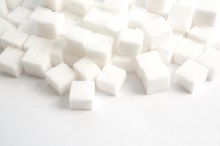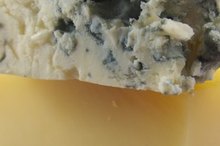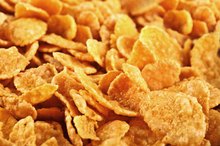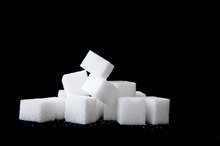Fructose, like table sugar, is an energy-containing compound that has a sweet taste. Your cells can burn fructose to provide immediate energy, or store it for later use in the form of either glycogen, a carbohydrate stored in the liver and muscles, or fat. If you're looking for a substitute for fructose in your food, there are several options available to you -- some of them contain calories, and others do not.
Glucose
While table sugar isn't a substitute for fructose, it actually contains fructose, you can use pure glucose to substitute for fructose. Unfortunately, both fructose and glucose contain identical numbers of calories per unit mass, but fructose is sweeter than glucose. This means, in general, you need to eat more calories worth of glucose to get the same sweetness you would from fewer calories worth of fructose. However, if you have fructose-induced digestive difficulties, as some individuals do, glucose may be a viable substitute. Sources of pure glucose include corn syrup and brown rice syrup.
- While table sugar isn't a substitute for fructose, it actually contains fructose, you can use pure glucose to substitute for fructose.
Aspartame
Sucrose, Dextrose & Maltodextrin
Learn More
Aspartame is a non-nutritive sweetener, meaning it contains no calories. Unlike glucose and fructose, aspartame isn't actually a sugar at all, explain Drs. Reginald Garrett and Charles Grisham in their book "Biochemistry." Instead, aspartame, sold under the brand name Equal, is a modified protein that happens to bind to the sweetness receptor on the human tongue 1. You can use aspartame instead of fructose to provide sweetness to foods, though unlike fructose, because aspartame contains no calories, it has no nutritional value whatsoever. Furthermore, unlike fructose, aspartame isn't heat stable, meaning you can't use it in baking.
- Aspartame is a non-nutritive sweetener, meaning it contains no calories.
- You can use aspartame instead of fructose to provide sweetness to foods, though unlike fructose, because aspartame contains no calories, it has no nutritional value whatsoever.
Sucralose
Another non-nutritive sweetener that you can use as a substitute for fructose is sucralose, often sold under the brand name Splenda. Sucralose is a modified sugar; it's very similar in chemical structure to table sugar, but has some chlorine atoms in it that table sugar doesn't have, in addition to a few other minor structural variations. The structural differences mean that you can't digest sucralose, because sugar-digesting enzymes are very structurally specific, explain Drs. Mary Campbell and Shawn Farrell in their book "Biochemistry." Sucralose, unlike aspartame, is heat-stable, so you can use it instead of fructose in baked goods and other cooked foods 2.
- Another non-nutritive sweetener that you can use as a substitute for fructose is sucralose, often sold under the brand name Splenda.
- Sucralose is a modified sugar; it's very similar in chemical structure to table sugar, but has some chlorine atoms in it that table sugar doesn't have, in addition to a few other minor structural variations.
Related Articles
References
- “Biochemistry”; Reginald Garrett, Ph.D. and Charles Grisham, Ph.D.; 2007
- “Biochemistry”; Mary Campbell, Ph.D. and Shawn Farrell, Ph.D.; 2005
- Popkin BM, Hawkes C. Sweetening of the global diet, particularly beverages: patterns, trends, and policy responses. Lancet Diabetes Endocrinol. 2015;4(2):174-186. doi:10.1016/S2213-8587(15)00419-2
- New Hampshire Department of Health and Human Services. How much sugar do you eat?. Updated August 2014.
- DeSilver D. How America's diet has changed over time. Pew Research Center. Updated December 13, 2016.
- Lakhan SE, Kirchgessner A. The emerging role of dietary fructose in obesity and cognitive decline. Nutr J. 2013;12:114. doi:10.1186/1475-2891-12-114
- Djiogue S, Nwabo Kamdje AH, Vecchio L, et al. Insulin resistance and cancer: the role of insulin and IGFs. Endocr Relat Cancer. 2013;20(1):R1-R17. doi:10.1530/ERC-12-0324
- Page KA, Chan O, Arora J, et al. Effects of fructose vs glucose on regional cerebral blood flow in brain regions involved with appetite and reward pathways. JAMA. 2013;309(1):63-70. doi:10.1001/jama.2012.116975
- Goran MI, Ulijaszek SJ, Ventura EE. High fructose corn syrup and diabetes prevalence: a global perspective. Glob Public Health. 2013;8(1):55-64. doi:10.1080/17441692.2012.736257
- Walker RW, Dumke KA, Goran MI. Fructose content in popular beverages made with and without high-fructose corn syrup. Nutrition. 2014;30(7-8):928-35. doi:10.1016/j.nut.2014.04.003
- American Heart Association. Added sugars. Updated April 17, 2018.
Writer Bio
Kirstin Hendrickson is a writer, teacher, coach, athlete and author of the textbook "Chemistry In The World." She's been teaching and writing about health, wellness and nutrition for more than 10 years. She has a Bachelor of Science in zoology, a Bachelor of Science in psychology, a Master of Science in chemistry and a doctoral degree in bioorganic chemistry.









